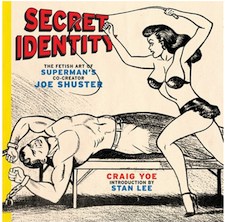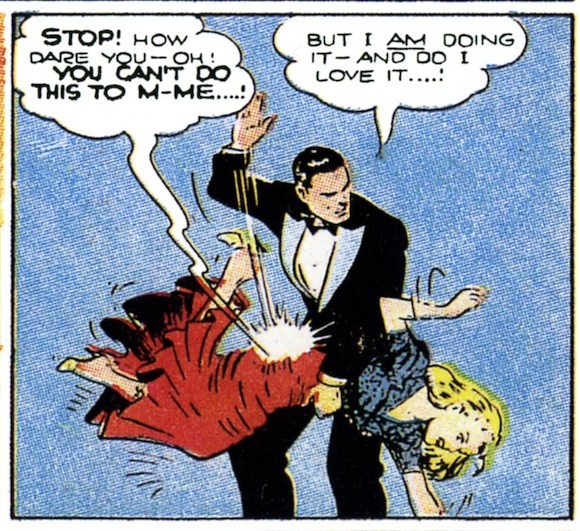This essay first appeared on Comixology.
_________________________
When Craig Yoe first saw the pulp fetish pamphlet Nights of Horror, he instantly gasped, “Oh, my God, Joe Shuster!”
 That expression of shock has a couple of levels to it, I think. First, of course, there’s the simple surprise of discovering unknown work by a seminal cartoonist. Artist Shuster and writer Jerry Siegel created the hugely successful Superman for National Comics in 1938. A decade and much legal wrangling later, though, Siegel and Shuster had lost the rights to their character, and were no longer welcome at the company which had been largely built on their creation. That much of the story is well known — but pretty much nobody was aware that the down-and-out Shuster had illustrated a low-budget porn title like Nights of Horror. In fact, given Shuster’s declining eyesight, some historians weren’t even sure that Shuster could see at all by the mid-1950s when Nights of Horror was produced.
That expression of shock has a couple of levels to it, I think. First, of course, there’s the simple surprise of discovering unknown work by a seminal cartoonist. Artist Shuster and writer Jerry Siegel created the hugely successful Superman for National Comics in 1938. A decade and much legal wrangling later, though, Siegel and Shuster had lost the rights to their character, and were no longer welcome at the company which had been largely built on their creation. That much of the story is well known — but pretty much nobody was aware that the down-and-out Shuster had illustrated a low-budget porn title like Nights of Horror. In fact, given Shuster’s declining eyesight, some historians weren’t even sure that Shuster could see at all by the mid-1950s when Nights of Horror was produced.
The amazement expressed by Yoe and by other comics professionals he quotes in Secret Identity: The Fetish Art of Superman’s Co-Creator Joe Shuster isn’t simply because the work was unknown, however. It’s because of the type of work it is, and the type of artist Shuster is supposed to be. Stan Lee, with his usual talent for dispensing middle-brow wisdom, pithily sums things up in the introduction. “Whereas everything about the stories and artwork of Superman was positive and uplifting, the pages of Nights of Horror…cater to the basest of man’s character and morals.”
So there you have it. Superman is good. Nights of Horror is evil. How, oh how, can we reconcile the two? Lee does it, characteristically, by genuflecting in the direction of tragic irony: Shuster loved the noble and good, but became “so disillusioned and desperate” that he debased his talents and turned to the dark side. Yoe himself isn’t that prudish, but he too sees a contrast. Superman was too perfect, Yoe argues. The discovery that Shuster had a less savory aspect, therefore, makes him, Yoe says, “someone we, with our own flaws can relate too.” Stan the Man looks on with distaste and Yoe looks on with avuncular amusement, but both agree on the central narrative, viz., it was a big step (whether down or sideways) from drawing Superman to drawing fetish art.
But was it? Not everyone thought so. Anti-comics crusader and psychologist Frederic Wertham for example, hated Superman and fetish pulp more or less equally, and for more or less the same reasons. Wertham believed that Superman encouraged “fantasies of sadistic joy in seeing other people punished.” The hyper-masculine, uniformed supermen were a sexualized, godless fantasy of force; a dream of limitless empowerment. Yoe quotes Wertham in the later’s famous screed, Seduction of the Innocent: “We established the basic ingredients of the most numerous and widely read comic books: violence, sadism, and cruelty; the superman philosophy, an offshoot of Nietzsche’s superman, who said, ‘When you go to women, don’t forget the whip.'”
As it happened, Wertham is on record condemning not only comic-book fetishism in general, but Nights of Horror specifically. The psychologist linked the fetish pamphlets to a series of brutal murders and assaults by a gang of young pseudo-Nazis in New York in 1954. As with super-hero comics, Wertham attacked Nights of Horror for its perversion, its sadism, and its general bad influence. Eventually, his testimony helped get Nights of Horror confiscated and destroyed by the state, in a decision upheld 5-4 by the Supreme Court.
Again, Yoe provides all of this information — but he doesn’t quite connect the dots. Perhaps he thinks too highly of Superman, or perhaps he’s simply unwilling or unable to credit rampant Comstockery. Nonetheless, the fact remains: in Wertham’s analysis, if not in his censorious conclusions, the crusading prude was definitely onto something. Whether it’s superheroes or fetish porn, pulp is pulp. And what pulp is made of, in large part is sadistic and masochistic fantasies. It’s not an accident that one of the earliest successful Batman villains, the Monk, was a vampire hypnotist who controlled the wills of his female victims. Nor is it coincidence that the incredibly popular early Wonder Woman stories featured elaborately bound beauties in just about every other panel. And as for Superman…well, how about this:
That’s a panel from the Superman newspaper strip which Siegel and Shuster worked on in the early ‘40s. It took me about a minute to find it by flipping at random through my volume of Superman: Sunday Classics.
So Shuster was into kink, then? Yoe does manage to uncover some evidence that the artist had an eye for chorus girls and the female form. But while that’s interesting, it’s not really the main issue. The point here isn’t that this or that creator had a personal thing for spanking or sadism or masochism. Rather, the point is that as a genre superhero comics simply aren’t that far removed from the kind of pulp fetish porn that Shuster retailed in Nights of Horror. Read through Yoe’s plot synopses of the sixteen plus issues that Shuster illustrated and you’ll get a definite feeling of déjà vu. Damsels in distress, evil hooligans, manly private dicks, and fiendish torture devices — didn’t Shuster illustrate all of this somewhere before? You’ve even got a fair number of men getting shown up just like that milquetoast Clark Kent…though, admittedly, Kent’s humiliation didn’t usually involve a French maid.
The consistency, though, goes beyond the simple details of the plot or the occasional oversexed Jimmy Olsen look alike. Both Nights of Horror and Superman have Shuster’s trademark, rough and ready stiff poses, forthright compositions, and linework-because-we-need-some-linework. It’s not slick, but it does have a kind of charming mass-market anonymity. The dominatrix on the cover of Secret Identity for example; Shuster drew her breast so it looks like a detachable sack draped over her shoulder. It’s as if he just chucked her together piecemeal for the pose, and plans to disassemble her as soon as you turn the page.
And then there are the picture frames on the walls of some of the dens of iniquity drawn in Nights of Horror — picture frames in which Shuster has neglected to place any actual pictures. Yoe suggests that these vacant blank squares evoke the emptiness and cruelty of the bleak pulp world. Really, though, it seems to me likely that Shuster didn’t draw pictures for the frames hanging in the background because…this is porn. Who’s looking at the damn pictures on the wall? Shuster isn’t creating art; he’s creating a delivery system.
This ability to focus on the main bit and ignore the frills was the genius of Superman too, of course. You want a power fantasy? Okay; we’ll give you a power fantasy. Super strength! Invulnerability! Constantly humiliating the girl you desire! What could be better than that, huh? Shuster knew a thing or two about catering to his audience’s desires. That he’d pander is not surprising — though the blatant obviousness of his vision still has the power to startle.


Your comment makes sense. I mean I realized long ago that all Frank Miller females were whores and all Frank Miller men lived to give and receive pain, I guess making Frank the ultimate pulp writer.
Well, he’d certainly like to be the ultimate pulp writer!
Which is why the earlier stuff is more interesting…. Carrie Kelly is not a whore. Neither is Ellen Yindel… etc.
Maybe my perspective is skewed by my notoriously libertine fandom, but I’ll always be miffed by grown adults who still arbitrarily draw a distinction between any high ideal and any sort of sexual activity.
BDSM is basically mainstream at this point, but I still hear really smart, thoughtful people pathologizing eroticized power exchange as somehow directly connected to sadism in everyday life.
It’s beyond dumb.
I don’t think it’s crazy to think that sadistic and masochistic fantasies might have some relationship to the way people treat each other in everyday life. To me, the point is that those fantasies are extremely widespread — they’re not just in specialty magazines (by Joe Shuster or others), for example, but are prevalent in superhero fantasies by Joe Shuster (and others.)
Whether those fantasies are positive or negative, and how you would define “positive” or “negative” seems like it’s something you need to decide on a case by case basis. But certainly demonizing subcultures or fandoms is silly, since, as you say, these impulses are so prevalent in every kind of popular culture.
“Which is why the earlier stuff is more interesting…. Carrie Kelly is not a whore. Neither is Ellen Yindel… etc.”
You haven’t read it close enough.
I’m with Eric on this I think; Robin in DK is an interesting character who doesn’t fall easily into the noir gender categories that Miller embraced more and more exclusively as his career has gone on.
It probably has something to do with her being a kid, but still. Credit where it’s due.
I should clarify that I was talking about pathologizing BDSM generally. I think there’s a clear difference between say Marsten’s Wonder Woman and Miller’s Sin City. The barrier of time has something to do with it. I’m less likely to assign sadistic motivation to Marsten than to Miller who creeps me out in the contemporary.
Or is there? I’m not intimately familiar with Marston’s specific take on womens’ subjugation in every day life and how that might have informed his imaginative drawings. It’s all very complicated, and I think my two cents have already been noted.
As far as explicit pornography is concerned, I think history supports your argument as to the wide-spread human fascination with power. Virtually all written porn from Victorian England adheres to a pulpy formula i.e. the less than consensual ravishings of virginal beauties by various Shieks of Araby.
Marston’s sado-masochism is tied (ahem) to explicit feminism. Women are better at submission than men, so men need to learn submission from them so that eventually women can rule, ushering in the millenium.
Frank Miller from what I’ve seen is much more conventional; strong women are hot, in part because that makes it more exciting for the strong(er) man to master them.
That’s what I thought, but I don’t want to talk out of school.
I was just making a joke, I didn’t really mean that the comic had sexism.
BDSM is still the go-to signifier for kink in culture at large, I think…which itself is probably evidence of how mainstreamed and unkinky it’s become, a kind of PG-13 fetish.
There’s a lot of pathologizing in the Garth Ennis/Steve Dillon et al. series Preacher, where anything outside, basically, straight-up hetero is is either played for laughs or, more usually, a sign of moral depravity (or sometimes both). It’s striking once you notice it, actually, how many of the series’ various villains are “perverted” in one way or another.
You should write a post about that. I totally missed it when I read those comics.
I’ll see what I can do. It should be ready in about fifteen years…
Heh. Well, if HU is still here, I’ll print it!